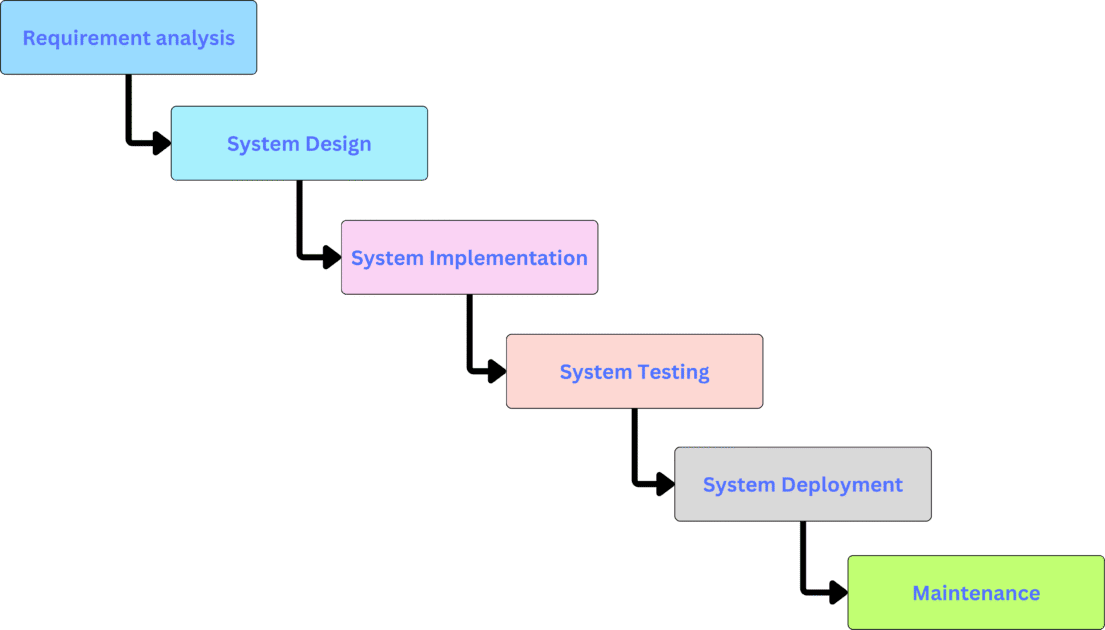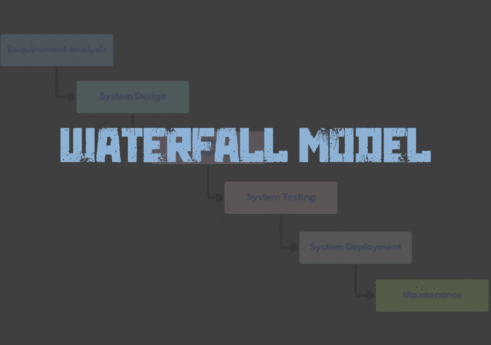Introduction
The Waterfall Model is a sequential software development approach in which each step must be completed before the next one begins. It describes a system development method that is linear and sequential system development model.
This waterfall model was first introduced by Dr. Winston W. Royce in 1970. It is a linear sequential design technique in which progress is shown to flow gradually downward, like a waterfall, through various phases such as requirements gathering, design, implementation, testing, deployment, and maintenance. Once a phase is completed, you do not revisit it. This methodology is most appropriate for projects with well-defined goals and consistent requirements. It is widely utilized in construction, manufacturing, defense, and embedded systems, which require predictability and structure.

Phases of the Waterfall model
Requirement analysis
The Requirement Gathering and Analysis phase is the first and most important step in the Waterfall software development process. During this phase, all prospective end-user and stakeholder needs are gathered to determine what the program should accomplish. Business analysts and project managers collaborate with clients to collect extensive information regarding the system’s functionality, performance, security, and usability. This phase relies significantly on documentation, with the result being a detailed Software Requirement Specification (SRS) document that details every aspect of the software’s behavior.
One distinguishing feature of the Waterfall Model is that after this phase is completed, the findings are set in stone. That means that any mistake or omission might have serious consequences in later stages. As such, this phase necessitates precision, clarity, and complete communication. Understanding the business context, user personas, and regulatory or compliance needs is essential, in addition to technical requirements. Teams recognize potential risks, restrictions, and dependencies early on.
System design
Once the requirements have been well established and documented, the project will proceed to the System Design phase. This is where the abstract ideas from the demand phase gain shape as a specific system architecture. During this phase, software architects and system designers collaborate to establish the application’s overall structure, which is broken down into modules and components. Design choices include programming languages, software platforms, data structures, database schemas, network setups, and interface designs.
The System Design phase of the Waterfall technique is divided into two sub-phases: High-Level Design (HLD) and Low-Level Design (LLD). High-Level Design focuses on the application’s general design and structure. It specifies the key modules, their interactions, and the data flow between them. Low-Level Design, on the other hand, goes into great depth about each module, outlining the logic, classes, functions, and relationships inside individual components. These design documents serve as a roadmap for developers during the implementation stage.
Implementation (Coding)
The implementation phase, sometimes known as the coding phase, is where the real software product begins to take shape. Based on the system design produced in the previous step, developers begin writing source code for each module or component. In Waterfall software development, this is simply translating design documents into a working application using the programming languages and tools of choice. Because the Waterfall Model takes a linear approach, the design must be completed and authorized before implementation begins.
During implementation, the development team often divides the project into smaller components, or modules. These modules are coded independently and then integrated into the system architecture. This phase also involves unit testing, which tests individual modules for proper functionality in isolation. While the main testing step occurs later, early testing during implementation helps detect obvious issues such as syntax errors, erroneous logic, or integration issues across modules.
The efficacy of the Implementation phase has a direct impact on the time and effort required throughout the succeeding testing and deployment stages. Well-written, efficient code with few flaws results in a smoother testing process and lowers the overall cost of software development. To summarize, the Implementation phase is when theoretical designs meet real implementation, and success is dependent on disciplined coding, adherence to specifications, and effective communication within the development team.
Testing
After the constituent modules are developed and unit-tested, the project moves on to the Integration and Testing phase. This stage is critical for ensuring that all pieces of the software function together seamlessly. Unlike Agile, where testing occurs throughout development, the Waterfall Model tests only once the coding process is complete. Because of its sequential structure, this step is critical in detecting faults that may have been introduced during previous stages.
During integration, all modules are assembled to form a complete system in accordance with the design plan. The emphasis is on system testing and integration testing, which check interactions between modules to ensure they function properly as a whole. The QA team also does functional testing, performance testing, security assessments, and user acceptability testing (UAT) to ensure that the product satisfies its original specifications.
This step also includes validation and verification—validation ensures that the program fulfills business requirements, whereas verification verifies that it was constructed properly. Thorough documentation of test results gives stakeholders confidence that the system is ready for deployment. Overall, the Waterfall Model’s Integration and Testing step assures that the finished program is reliable, functional, and ready for live deployment.
System deployment
The Waterfall Model’s Deployment phase represents the software product’s move from the development to the production environment. This is the stage at which the final application is made available for end users to access and utilize. All preceding phases—requirements collection, design, development, and testing—have been completed prior to deployment, therefore the software is expected to be fully functional and bug-free.
During this step, the deployment team installs the program on servers or user PCs, configures any necessary system settings, and ensures that the environment is compatible with the new application. This process may also include database migration, backup configuration, and integration with existing infrastructure. In enterprise environments, implementation can be phased, beginning with a pilot group of users and progressing to a full-scale rollout once first feedback is positive.
The success of this phase is greatly dependent on how well the preceding stages were completed. Any uncovered problems or missing functionality at this phase can result in costly fixes, downtimes, or even reputational harm. However, if all testing and validation stages were completed thoroughly, deployment can be a simple and flawless process. In essence, the Deployment phase provides the finished product to its users, bringing all prior planning, development, and testing efforts to fruition.
System maintenance
Even when the program has been successfully delivered, the work is not yet complete. Maintenance is the final step of the Waterfall Model, and it includes continuing support, error repair, performance improvements, and, on occasion, modest modifications. This step is critical because real-world use frequently reveals flaws, usability concerns, or compatibility issues that were not detected during testing.
Major changes or new features are rarely accommodated within the same cycle in the Waterfall Model, necessitating the commencement of a new project. This rigid character might be a disadvantage in dynamic contexts, but it performs well in tasks that require stability. Since the software is currently in production, updates must be handled with caution to avoid introducing new issues. Even modest changes are rigorously tested to ensure they do not damage the system.
When to use the waterfall model?
- This model is used only when the requirements are very well known, clear, and fixed.
- Product definition is stable.
- Technology is understood.
- There are no ambiguous requirements. Simple resources with required expertise are available freely.
- The project is short.
- If the developer circle is small.
Advantages
- This model is simple and easy to understand and use.
- It is easy to manage due to the rigidity of the model – each phase has specific deliverables and a review process.
- In this model, phases are processed and completed one at a time.
- Phases do not overlap.
- The waterfall model works well for smaller projects where requirements are very well understood.
Disadvantages
- Once an application is in the testing stage, it is very difficult to go back and change something that was not well-thought-out in the concept stage.
- No working software is produced until late in the life cycle.
- High amounts of risk and uncertainty.
- Not a good model for complex and object-oriented projects.
- Poor model for long and ongoing projects.
- Not suitable for projects where requirements are at a moderate to high risk of changing.


